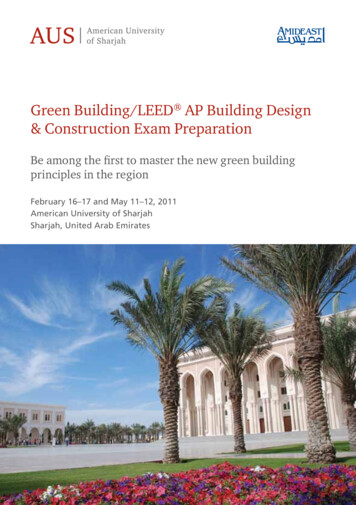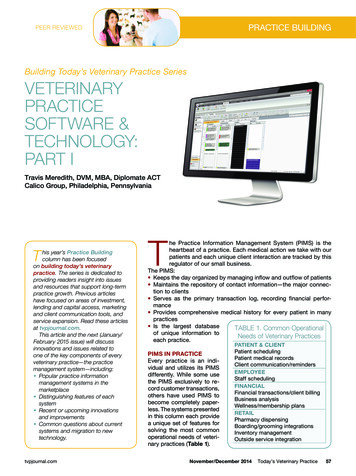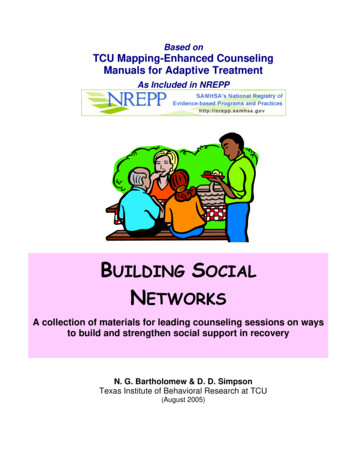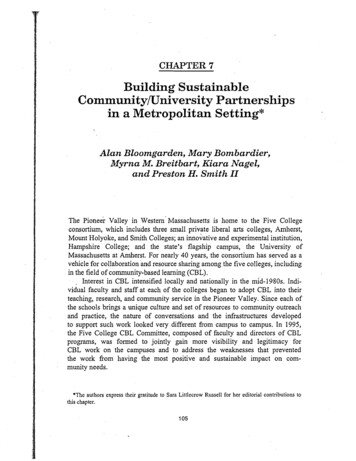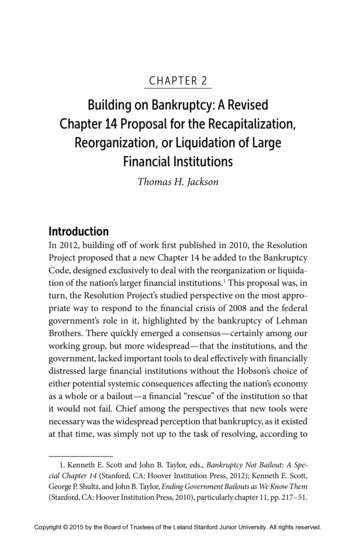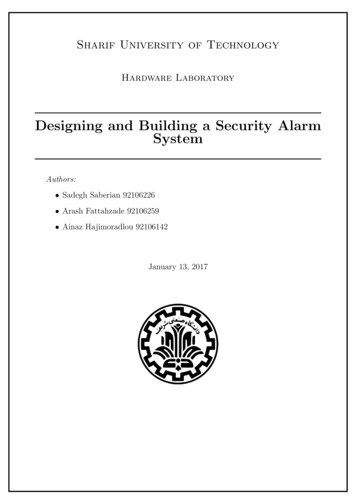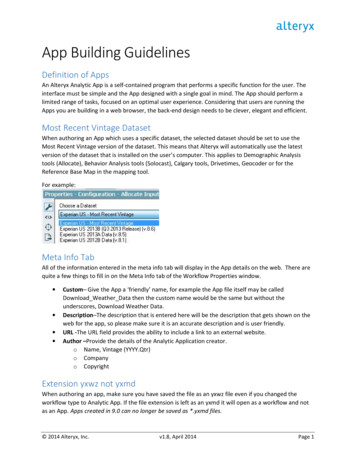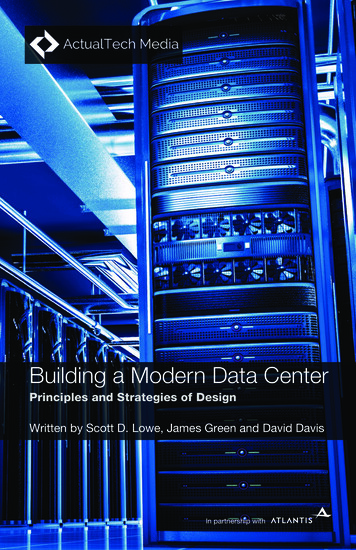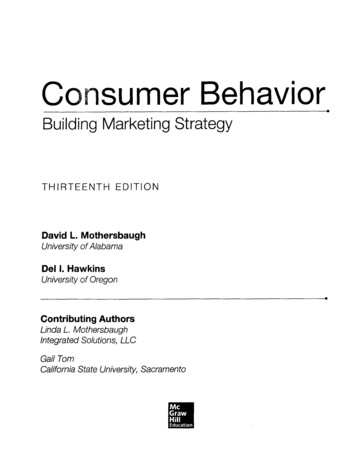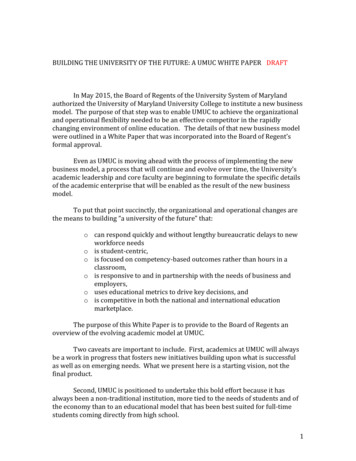
Transcription
BUILDING THE UNIVERSITY OF THE FUTURE: A UMUC WHITE PAPER DRAFTIn May 2015, the Board of Regents of the University System of Marylandauthorized the University of Maryland University College to institute a new businessmodel. The purpose of that step was to enable UMUC to achieve the organizationaland operational flexibility needed to be an effective competitor in the rapidlychanging environment of online education. The details of that new business modelwere outlined in a White Paper that was incorporated into the Board of Regent’sformal approval.Even as UMUC is moving ahead with the process of implementing the newbusiness model, a process that will continue and evolve over time, the University’sacademic leadership and core faculty are beginning to formulate the specific detailsof the academic enterprise that will be enabled as the result of the new businessmodel.To put that point succinctly, the organizational and operational changes arethe means to building “a university of the future” that:o can respond quickly and without lengthy bureaucratic delays to newworkforce needso is student-centric,o is focused on competency-based outcomes rather than hours in aclassroom,o is responsive to and in partnership with the needs of business andemployers,o uses educational metrics to drive key decisions, ando is competitive in both the national and international educationmarketplace.The purpose of this White Paper is to provide to the Board of Regents anoverview of the evolving academic model at UMUC.Two caveats are important to include. First, academics at UMUC will alwaysbe a work in progress that fosters new initiatives building upon what is successfulas well as on emerging needs. What we present here is a starting vision, not thefinal product.Second, UMUC is positioned to undertake this bold effort because it hasalways been a non-traditional institution, more tied to the needs of students and ofthe economy than to an educational model that has been best suited for full-timestudents coming directly from high school.1
UMUC TodayUMUC is already unique within the University System of Maryland. While itsacademic programs are numerous, diverse, of high quality, and academicallyrigorous, it bears little other resemblance to a traditional university: its students arenot young, it has no dormitories, or football team. Moreover, it has been engaged ina process of rapid transformation over the past two decades that has served tofurther distinguish it from other public institutions in the State.Some of the differences are familiar to you. UMUC has always focused onadult learners who are usually older than traditional college age students, havecompeting priorities including work and family, and require different supportsystems than students on a residential campus.Another attribute of the university is its widely dispersed student body.Starting with educational offerings for the military in Asia and Europe in the 1940s,UMUC has always been more than just a Maryland institution. With the rapidexplosion of online courses, UMUC now is among the largest universities in theworld and competes in a field where change is constant.In FY 2014 UMUC enrolled approximately 85,000 students worldwide.Of these, 87 percent took at least one course online; UMUC had more than243,000 online course enrollments and offered 981 distinct courses online.In fact, the vast majority of students worldwide complete their degreespredominantly online.Currently, UMUC offers over 70 undergraduate and graduate degree andcertificate programs. Every program can be completed online, with the exception ofthe Doctor of Management program, which has weekend residency requirements.Due to increasing student demand for learning online, no program is now offeredentirely onsite.These characteristics of the present day institution have led to distinctiveapproaches in:ooooIts programmatic offerings,The role of faculty at UMUC,The focus on technology-enhanced learning, andReliance on data-driven decision making.These attributes form the foundation on which UMUC expects to continueevolving its academic model in response to an international education market thatwill change in ways and whose future shape no one can accurately predict today.In the following sections, the White Paper first describes the currentconfiguration of each of the elements referred to in the preceding paragraph. Then,2
the likely next stages are presented with the recognition that change will becontinuous.Finally, a concluding section discusses a range of potential new ventures thatgo beyond the current boundaries of what we now know as UMUC. The central goalof this entire enterprise is to create and continuously adapt an educationalinstitution that provides high quality education to a growing market of students inMaryland, the nation, and the world.Academic Programs at UMUCFrom a starting point of adult students taking most of their courses online,the nature of academic programs—their development, focus, learning assumptionsand relationship to the world of work—is different at UMUC than at most traditionaluniversities.The degree program is the basic building block of academics rather than theindividual course. That relatively simple statement is in fact a radical idea withincontemporary higher education. The primary focus in creating any particularacademic degree—and it may be easier to think first of graduate programs—is toidentify the learning objectives and skills that are the intended outcomes for astudent taking the program.Using that premise, every course as well as the sequence of courses is tied tothe learning objectives. Learning by doing, and doing repeatedly, will be built intoeach program through the inclusion of certain skills in multiple courses. The goal isto ensure that every graduate of the program has mastered a set of competencies thatare viewed as critical to the particular field.Utilizing data that is generated by online courses, it is possible to determinewhether a student has mastered a skill in class 3 that is essential for moving to amore advanced level in class 5. Ultimately, the logic of this approach may lead toevaluations of student progress that are based on their ability to master particularcompetencies rather than by the amount of time they spend in class.To make this system work, it’s important that each section of a courseprovide the same material as every other section. As a result, UMUC is moving to astandardization of curriculum, educational materials, and syllabi. There is acentralized course development process, which allows instructors to then focus onstudent learning. This point is described more fully in the section on faculty.A recent innovation that is now being fully implemented is the use of openeducational resources rather than standard textbooks. Besides saving students theconsiderable expenses incurred, this approach allows the most current materials tobe available for each class. The class is no longer defined by the textbook, butinstead uses educational resources to support the learning objectives.3
The curricular challenge for UMUC is a bit different for undergraduateprograms than it is for graduate degrees. In the first place, almost all of UMUC’sstudents come with some prior learning, including but not limited to college courses.As the university more fully adopts a competency model, prior work and lifeexperience, systematically and rigorously evaluated, will be part of a student’spathway to an undergraduate degree.As with graduate programs, the objective of identifying and incorporatingclear learning objectives and relevant skills is also a part of the undergraduateeducation model. Regardless of a student’s prior college experience, the specificcourses that constitute a major and the sequence of those courses is carefullystructured to ensure that the student achieves the competencies needed in the field.One important step that the university has recently taken has been todramatically streamline undergraduate degree pathways. There is a growingconcern in higher education that the almost unlimited and unrelated panoply ofcourses available in most universities results in undergraduate degrees with littlecoherence or core knowledge. Too many courses are stand-alone outliers, taughtprimarily because they reflect the interest of one faculty member.Within the number of credits that a student transferring to UMUC needs tofulfill the requirements for an undergraduate degree, there is a focus on competency,learning by doing, and specific skills. To reiterate a key point, most UMUC studentsalready have work experience and are looking to augment the knowledge and skillsfor future employment and careers.An important disclaimer is in order at this point. For some readers, the priordiscussion may sound like a description of career or vocational education. That’s afalse dichotomy. The same fundamental skills—analyzing, writing, organizing,communication, critical thinking—are at the heart of a liberal arts education as arerequired to be successful in the work place.Indeed, employers frequently comment that college graduates, regardless oftheir major, often lack these fundamental skills. We are committed at UMUC toensuring that all students entering the world of work have the ability to succeed inboth their career and their day-to-day lives. Being able to function as well-informedand thoughtful citizens is no less important than the other areas of their lives.Two final points will get additional attention in subsequent sections. First,the development of new programs and the modification of existing ones are heavilyinfluenced by ongoing interaction with employers and businesses. Understanding thecompetencies and skills that are necessary for success in any particular field as wellas being able to identify emerging fields is critical if UMUC is to be a leader in theeducational market. To cite a contemporary example, spring 2016 courses in cyber-4
security will use the hacking of the Office of Personnel Management’s web site as acase study.Higher education is in many ways a highly regulated market. There arenumerous rules and procedures that must be followed before a new program can beoffered. That model is out of date, even anachronistic. We live in a global economywhere borders are not nearly as important as they once were. Competitors are notmerely within the state or even the nation.UMUC’s ability to respond to the workforce needs of a rapidly changingenvironment will require the ability to bring new academic programs to the market inreal time, not bureaucratic time. That’s a challenge for the future, but that future isnow.The Role of FacultyFew aspects of UMUC are more misunderstood than the role of faculty. Thatproblem results from the fact that the faculty model at UMUC is fundamentallydifferent than that at traditional universities. Most observers know and haveexperienced the traditional model and generally see it as the “correct” one.Let’s start with a fact that is widely known about UMUC’s faculty. Theoverwhelming proportion of adjuncts who teach for UMUC are workingprofessionals in their fields. Following UMUC’s long-time model of employing scholarpractitioners – highly skilled professionals working in their field who wish to shape thenext generation of professionals through teaching – most courses are taught byadjunct faculty members teaching one to two sections per term. Their real worldexperience is what they bring to a UMUC classroom. Most do not rely onemployment at UMUC as their primary source of family income or their access tobenefits.The heavy reliance on adjuncts is one factor that has allowed UMUC to growdramatically as well as to offer courses all over the world to the United Statesmilitary. But UMUC’s adjuncts are on the whole different than the adjuncts that youread about in articles in the Chronicle of Higher Education that highlight theirdifficult working conditions.It is not uncommon at UMUC to offer dozens of sections of the same course inthe same term. Were each adjunct faculty member to develop that contentindividually, the variation from student to student on what was learned would betoo high. Moving towards the standardization and uniformity of course materials andoutlines ensures that every course sets its students up for success in the rest of theirprogram. Where our scholar-practitioner adjunct faculty members can and dobring incredible value is in the facilitation of the course, helping students to connectlearning to the profession, bringing in real-world examples and currency.5
Every institution has a culture, and for any employee – faculty or staff – to behappy and thrive, that culture must be a good fit. The mission, vision and valuesmust resonate. UMUC has not always been as explicit as it might be in this area, inparticular with respect to new faculty hiring, screening and training, and there willbe continued evolution. UMUC has taken some important steps, however. Theadjunct faculty job description is now standardized across the university, and it laysout the qualitative expectations we have for effective teaching. Further, there is anew faculty-training course, steeped in what we know about how learners learn, inparticular adult and military learners, that is required of all individuals who teachfor UMUC.As new programs are developed and new markets are explored, the processof recruiting and assessing new adjuncts will become more rigorous. For example,there will be clear expectations about competencies in the use of technology thathave not always been in place. Similarly, making sure that new adjuncts fullyunderstand UMUC students and how they differ from traditional college studentswill receive greater emphasis.Monitoring and evaluation of a large cohort of adjuncts is obviously achallenge, but one that has received a lot of attention. Program chairs conductonline classroom observations as one method of evaluation. A new standard formathas just been developed that should ensure greater uniformity in that process.Additionally, however, online classes generate a wealth of useful data, someof which can be used to determine real time whether a faculty member is helpingstudents succeed in the classes he or she teaches. UMUC is a national leader in theuse of data analytics and this piece will become even more important over time.The core faculty, the program chairs and twelve-month teaching collegiatefaculty, are responsible for taking the lead in curriculum development, interactionwith employers about curriculum, oversight of adjuncts, and interaction withuniversity administrators on the overall direction of UMUC. UMUC faculty do nothave the same research expectations of them that many traditional universityfaculty do, but they all have major and important leadership responsibilities.This section would not be complete without a discussion of the teachingmodel that is evolving at UMUC, one that applies to both full-time faculty andadjuncts. With the emphasis on acquiring specific competencies related to aparticular degree program and with students who are mostly working adults, atraditional model of teachers as predominately transmitters of information doesn’twork well. In fact, there is an ongoing conversation in higher education as a wholeabout the evolving role of faculty, but this discussion will limit itself to UMUC faculty.Rather than lecturing or providing the online version of a lecture, theexpectation is that faculty will serve as mentors or guides to students in theirclasses. There has been discussion for years in higher education about moving away6
from the “sage on the stage” approach to teaching. At UMUC, we have been steadilyand systematically moving in that direction. At UMUC, with its emphasis on workingstudents acquiring professional skills and with faculty who are practitioners in theirfields, the mentor model seems particularly appropriate. Making it clear to futurefaculty hires that they are expected to be mentors rather than sages will help bringabout a transformation. Training and mentoring for faculty will also help change theteaching model.All of this really is a work in progress. The approach to teaching described inthis section is an essential part of the overall educational model that UMUC is in theprocess of creating. Some of it is already in place, but the model will continue toevolve over time.Technology and LearningUMUC is already well known as a leading online university. The fact thatmany of its students take their courses through the Internet rather than in aclassroom is really just the tip of the technology iceberg.Two of the most familiar aspects of higher education take a totally differentform at UMUC than was the case for anyone who attended college before the digitalage.First, UMUC does not have a library in the traditional sense that most peopleuse that term. No stacks, no card catalog, no multi-floor building. Instead, UMUC’slibrary is entirely online and its full array of resources is available to anyoneregardless of where they are in the world. Books, periodicals, governmentdocuments, business reports and just about anything else you can think of can beaccessed by a student through her or his computer.The digital library provides more materials more readily than any traditionallibrary. The collection continues to expand and the types of materials that will beavailable in the future have no obvious limit. Not subject to time or distanceconstraints, UMUC’s library enables students to conduct research, examine primarydocuments, and access rare materials in a way that was never possible in atraditional university library.At UMUC librarians support learning design and development by findinglearning resources for program chairs who can then use them as part of theprogram and courses. They also are involved in the ongoing search for high qualityopen educational resources.This exciting resource does require learning a new set of search and researchskills, but students are exposed to those skills throughout their academic programat UMUC. The skills in turn become a critical asset in lifelong learning whether atUMUC or after graduation.7
In addition, UMUC is moving toward final stage of a plan to totally eliminatethe use of publisher textbooks and to instead provide all students in all courses withaccess to open-source learning materials at no cost to students. While this is certainlya revolutionary breakthrough, it is also a logical extension of online education.There is been a major debate in recent years about the high cost of collegetextbooks. Various states, including Maryland, have attempted by public policy toput limits on the costs or at least to ensure that the lowest cost option was madeavailable to students. These efforts have for the most part had only a marginalimpact on the cost to students.UMUC’s initiative will totally eliminate all textbook costs to the student.Through a combination of open access materials, subscription items that UMUC paysthe cost of for all students, and searchable databases, traditional textbooks willbecome obsolete.In 2015, UMUC received the President’s Award from the Open EducationConsortium for this initiative. This achievement is an additional external validationof the university’s leadership in online education.In addition to cost savings, there are at least two significant educationalbenefits. First, class materials will be much more up to date as a result of thischange. The production process for textbooks means that they are at least a year ortwo out of date by the time they are available to a student. Real time materials willbe the norm in this new system.Second, classes can be organized around the learning objectives rather thanaround the structure of a textbook. UMUC’s course development process, withteams working to plan a course and identify the appropriate materials, allows acomprehensive approach to the learning objectiv
authorized the University of Maryland University College to institute a new business model. The purpose of that step was to enable UMUC to achieve the organizational . o is focused on competency-based outcomes rather than hours in a classroom, o is responsive to and

